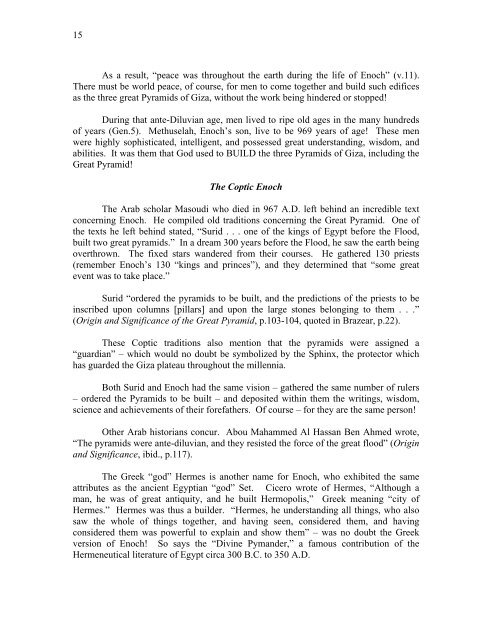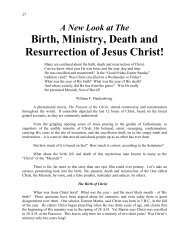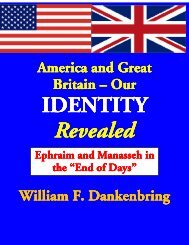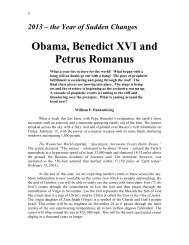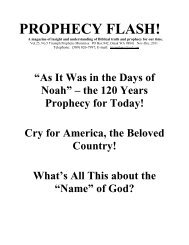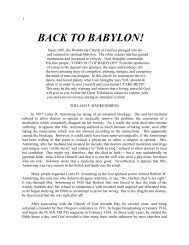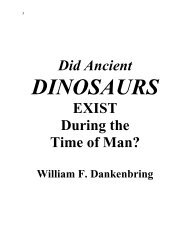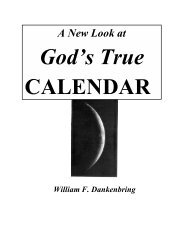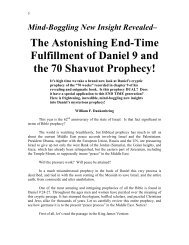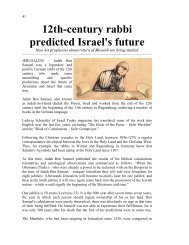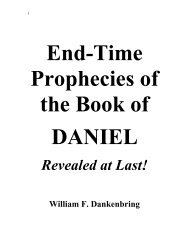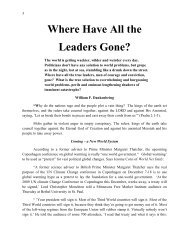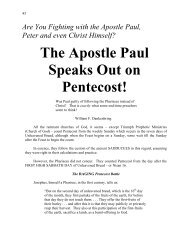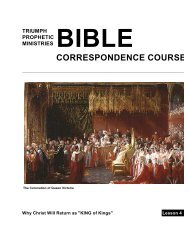Mystery of the Great Pyramid - Triumphpro.com
Mystery of the Great Pyramid - Triumphpro.com
Mystery of the Great Pyramid - Triumphpro.com
You also want an ePaper? Increase the reach of your titles
YUMPU automatically turns print PDFs into web optimized ePapers that Google loves.
15<br />
As a result, “peace was throughout <strong>the</strong> earth during <strong>the</strong> life <strong>of</strong> Enoch” (v.11).<br />
There must be world peace, <strong>of</strong> course, for men to <strong>com</strong>e toge<strong>the</strong>r and build such edifices<br />
as <strong>the</strong> three great <strong>Pyramid</strong>s <strong>of</strong> Giza, without <strong>the</strong> work being hindered or stopped!<br />
During that ante-Diluvian age, men lived to ripe old ages in <strong>the</strong> many hundreds<br />
<strong>of</strong> years (Gen.5). Methuselah, Enoch’s son, live to be 969 years <strong>of</strong> age! These men<br />
were highly sophisticated, intelligent, and possessed great understanding, wisdom, and<br />
abilities. It was <strong>the</strong>m that God used to BUILD <strong>the</strong> three <strong>Pyramid</strong>s <strong>of</strong> Giza, including <strong>the</strong><br />
<strong>Great</strong> <strong>Pyramid</strong>!<br />
The Coptic Enoch<br />
The Arab scholar Masoudi who died in 967 A.D. left behind an incredible text<br />
concerning Enoch. He <strong>com</strong>piled old traditions concerning <strong>the</strong> <strong>Great</strong> <strong>Pyramid</strong>. One <strong>of</strong><br />
<strong>the</strong> texts he left behind stated, “Surid . . . one <strong>of</strong> <strong>the</strong> kings <strong>of</strong> Egypt before <strong>the</strong> Flood,<br />
built two great pyramids.” In a dream 300 years before <strong>the</strong> Flood, he saw <strong>the</strong> earth being<br />
overthrown. The fixed stars wandered from <strong>the</strong>ir courses. He ga<strong>the</strong>red 130 priests<br />
(remember Enoch’s 130 “kings and princes”), and <strong>the</strong>y determined that “some great<br />
event was to take place.”<br />
Surid “ordered <strong>the</strong> pyramids to be built, and <strong>the</strong> predictions <strong>of</strong> <strong>the</strong> priests to be<br />
inscribed upon columns [pillars] and upon <strong>the</strong> large stones belonging to <strong>the</strong>m . . .”<br />
(Origin and Significance <strong>of</strong> <strong>the</strong> <strong>Great</strong> <strong>Pyramid</strong>, p.103-104, quoted in Brazear, p.22).<br />
These Coptic traditions also mention that <strong>the</strong> pyramids were assigned a<br />
“guardian” – which would no doubt be symbolized by <strong>the</strong> Sphinx, <strong>the</strong> protector which<br />
has guarded <strong>the</strong> Giza plateau throughout <strong>the</strong> millennia.<br />
Both Surid and Enoch had <strong>the</strong> same vision – ga<strong>the</strong>red <strong>the</strong> same number <strong>of</strong> rulers<br />
– ordered <strong>the</strong> <strong>Pyramid</strong>s to be built – and deposited within <strong>the</strong>m <strong>the</strong> writings, wisdom,<br />
science and achievements <strong>of</strong> <strong>the</strong>ir forefa<strong>the</strong>rs. Of course – for <strong>the</strong>y are <strong>the</strong> same person!<br />
O<strong>the</strong>r Arab historians concur. Abou Mahammed Al Hassan Ben Ahmed wrote,<br />
“The pyramids were ante-diluvian, and <strong>the</strong>y resisted <strong>the</strong> force <strong>of</strong> <strong>the</strong> great flood” (Origin<br />
and Significance, ibid., p.117).<br />
The Greek “god” Hermes is ano<strong>the</strong>r name for Enoch, who exhibited <strong>the</strong> same<br />
attributes as <strong>the</strong> ancient Egyptian “god” Set. Cicero wrote <strong>of</strong> Hermes, “Although a<br />
man, he was <strong>of</strong> great antiquity, and he built Hermopolis,” Greek meaning “city <strong>of</strong><br />
Hermes.” Hermes was thus a builder. “Hermes, he understanding all things, who also<br />
saw <strong>the</strong> whole <strong>of</strong> things toge<strong>the</strong>r, and having seen, considered <strong>the</strong>m, and having<br />
considered <strong>the</strong>m was powerful to explain and show <strong>the</strong>m” – was no doubt <strong>the</strong> Greek<br />
version <strong>of</strong> Enoch! So says <strong>the</strong> “Divine Pymander,” a famous contribution <strong>of</strong> <strong>the</strong><br />
Hermeneutical literature <strong>of</strong> Egypt circa 300 B.C. to 350 A.D.


